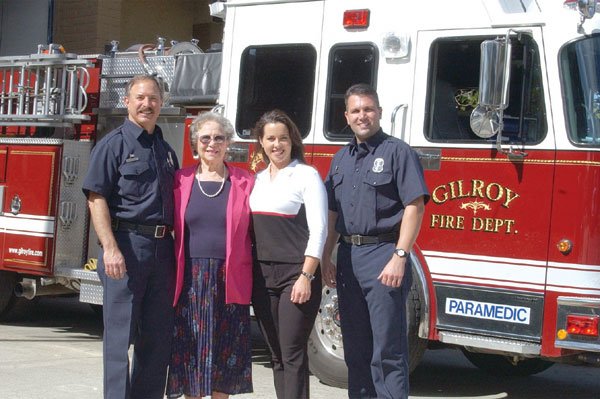So often it’s easy for us Gilroy locals to take for granted the
fact that we have dedicated professionals like 9-1-1 operators,
police officers, firefighters, paramedics, ER doctors and
nurses
– professionals who are on duty 24 hours per day, seven days per
week, year around.
So often it’s easy for us Gilroy locals to take for granted the fact that we have dedicated professionals like 9-1-1 operators, police officers, firefighters, paramedics, ER doctors and nurses – professionals who are on duty 24 hours per day, seven days per week, year around. When you find yourself in an emergency situation requiring emergency action, you suddenly realize how important these people are especially when life and death are hanging in the balance. Our family had such an emergency need back in late May.
My mother-in-law Melba McMichael, who lives with us, has been in good health and very active for an 80-year-old. So it was very unusual that particular May afternoon when she complained of pain across her shoulder blades and in her jaw. Her color became progressively gray – not normal, not good. After some quick debate about driving her to the hospital, she finally agreed. But then she said she felt worse, and couldn’t go. After weighing our options, I made the decision to dial 9-1-1. Within moments after that call, she collapsed unconscious. Now had our family not been gathered for a mini-reunion that day, it would have been her departure from this world, since she would have been alone in the house.
In an emergency, there are few things worse than dialing 9-1-1 and getting a busy signal. The whole purpose of 9-1-1 is to report emergencies – dangerous or life threatening situations to persons or property that require immediate action. I know from personal experience the public can be extremely dumb when it comes to making 9-1-1 calls. Emergency operators typically receive more non-emergency calls (e.g. barking dogs) than emergency calls. This can waste valuable time for real emergencies.
As the wail of sirens grew from faint to loud (and those sirens were the most welcoming sound I’ve ever heard) Gilroy Engines 71 and 73 from the Las Animas Fire Station pulled into our cul-de-sac. What happened then is described by the Gilroy Fire Department’s own records:
“When [the firefighter-paramedics] got to the patient they found the patient’s granddaughter [Joy Booker] performing CPR. The crew took over ventilations and connected the patient to the cardiac monitor along with other monitoring devices. The patient was in cardiac arrest and showed ventricular fibrillation on the screen. Within two minutes of arrival, firefighter paramedic Scott MacDonald defibrillated her at 200 joules and she converted to a flat line – no cardiac electrical activity. The crew then placed her on the floor to continue CPR and found that the patient now was in a junctional rhythm (a rhythm that originates not from the normal area of the heart) with multi-focal PVC’s (premature ventricular contractions of multiple forms which are the most dangerous PVCs – that often result in V-Fib and sudden death). Following these procedures, they continued to support ventilations and established an IV (intravenous line to enable the direct administration of medications which follow revival because the patient often slips back into the dangerous rhythms).
The patient then had a change back to V-fib. The paramedics immediately defibrillated her again. The patient then converted again to a junctional rhythm with PVCs. The drug Lidocaine was administered by IV to help the heart maintain this viable rhythm. The patient continued to have spontaneous respirations and strong radial pulses. This entire sequence of events occurred within approximately five minutes. Once stabilized, the patient was prepared for transport [to the hospital] as the AMR ambulance unit arrived.”
Fortunately, the outcome of this emergency ended happily. Although my mother-in-law had suffered a major heart attack, by the grace of God, she had no major heart damage thanks to the timely action of the Gilroy Fire Department and a family member who knew how to administer CPR. Some two weeks later, my mother-in-law visited the Las Animas Fire Station to thank the same firefighters (with boxes of chocolate) who saved her life. And today, she’s more active than ever.
As I thought about our emergency, I want to share three suggestions:
• Be prepared, make sure that at least one adult in your family is trained to administer CPR.
• Make sure that all members of your family are educated as to what is an emergency and what is not an emergency.
• Make sure that your children understand dialing 9-1-1 is not a joke, or to be done for fun or amusement. It’s serious business.
Finally, on behalf of our family, I want to thank GFD acting Captain Roy Shackel, acting Engineer Dave Olds, Firefighter-Paramedic Scott MacDonald, Firefighters Mike Pardini and Raul Pantoja for a job well done. Also, thanks to GFD-EMS Division Chief Phil King who heads Gilroy FD’s paramedic service. To all of you, we greatly appreciate your professionalism and dedication to service in our city.












